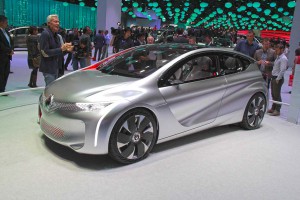
New emissions standards, in general, are “one of the toughest issues we face,” said Sergio Marchionne, during the Paris Motor Show.
Facing growing concerns about air quality, global warming and long-term energy supplies, European regulators have begun to debate the possibility of sharply tightening already-strict vehicles emissions standards – but senior automotive executives gathered for this year’s Paris Motor Show are warning such a move could be “fatal” for the auto industry.
Manufacturers say they could, in fact, meet the rules some clean air advocates have been proposing. At least from a technical standpoint, but the cost could be substantial, especially for smaller carmakers, they warn. And of equal concern, industry leaders question whether consumers would be willing to accept the potential compromises or pay the higher prices they’d almost certainly face.
Europe already has enacted some of the world’s toughest clean air standards. Unlike the United States, which focuses on fuel economy, the EU has been targeting carbon dioxide emissions in an effort to reduce global warming. The current standard will be cut by about a quarter, to a mere 95 grams of carbon dioxide for every kilometer of driving by 2021, roughly equivalent to what a car meeting Americas 54.5 mpg fuel economy standard would have to meet in 2025.
But Brussels-based regulators are talking about trimming that to just 65 grams by 2025 – which would be the equivalent of getting 84 miles per gallon. To put that into perspective, even the Toyota Prius today manages to deliver just 50 mpg.

The Renault Eolab sips barely 1 liter of fuel every 100 km, and gets 37 miles per charge, and would be able to meet the proposed new Euro emissions rules.
“That’s why I worry,” said Volkswagen CEO Martin Winterkorn, who warned such a move could be “fatal.” Speaking at an industry conference tied to the Paris show, Winterkorn noted that for every gram of carbon dioxide the target is cut, VW has to invest about 100 million Euros – about $140 million – “without knowing when these investments pay off.”
He isn’t the only one worried. New emissions standards, in general, are “one of the toughest issues we face,” said Sergio Marchionne, CEO of the recently merged Fiat Chrysler Automobiles, during a news conference at the Paris Motor Show.
Industry observers say that as tough as the proposed standards might be for the world’s largest automakers, VW, Toyota, General Motors and Ford among them, tighter regulations would be especially devastating to smaller companies with fewer resources.
Industry critics remain skeptical of such claims. They are quick to point out that automakers have been raising the specter of doom and gloom since the first clean air rules were passed in the 1970s – but manufacturers have so far achieved substantial results, both in reducing emissions and in raising mileage.
(No bull…Lamborghini heats up horsepower race with Asterion concept. For more, Click Here.)
And, indeed, manufacturers acknowledge they have not hit the wall. They continue to make gains by adopting new technologies, such as direct injection, turbocharging and more advanced transmissions. But they insist these systems won’t go nearly far enough.
How far is possible? The Renault Eolab concept on display at the Paris Motor Show is claimed to yield a stunning 235 miles per gallon through the use of ultralight materials like carbon fiber and aluminum, by improving its aerodynamics, and by switching to a super-efficient hybrid powertrain pairing a 1.0-liter diesel engine and an electric motor.
(Click Here for details on GM’s recall of 524,000 vehicles.)
Even luxury makers are exploring their options. The Lamborghini Asterion LPI-4 Concept supercar produces 907 horsepower yet can travel up to 31 miles on its batteries alone.
Of course, a production version would be priced far beyond the reach of the typical Paris showgoer. And while Renault hasn’t projected a price for the Eolab, VW is charging $170,000 for a similarly efficient ultracar, its 2-seat XL1.
(To see more about Mercedes new Porsche-fighting AMG GT, Click Here.)
It is possible to meet almost any standard regulators set, according to industry planners. “But it will mean a shift in pricing,” Fiat Chrysler’s Marchionne says, adding that those who think the industry can meet some of the proposed rules at an affordable price “are deluding themselves.”
Whether regulators will listen to such concerns or see the industry as just crying wolf remains to be seen, but there’s little doubt that the upcoming discussions will amount to a very high-stakes poker game balancing the environment, the health of the auto industry and the needs and desires of consumers.

This is complete INSANITY!
Maybe it’s time to look at hiring policies.